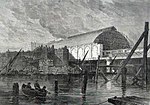Hungerford Market

Hungerford Market was a produce market in London, at Charing Cross on the Strand. It existed in two different buildings on the same site, the first built in 1682, the second in 1832. The market was first built on the site of Hungerford House, next to Durham Yard, the town house of the Hungerford family. The house had burned down in 1669 as is recorded in the Diary of Samuel Pepys. It was replaced by a new Italianate market building by Charles Fowler, which opened in 1833. The new market was unsuccessful. It was damaged when the adjoining Hungerford Hall burned down in 1854, and was sold to the South Eastern Railway in 1862. Charing Cross railway station was built on the site and opened in 1864.
Excerpt from the Wikipedia article Hungerford Market (License: CC BY-SA 3.0, Authors, Images).Hungerford Market
Northumberland Street, City of Westminster Covent Garden
Geographical coordinates (GPS) Address Nearby Places Show on map
Geographical coordinates (GPS)
| Latitude | Longitude |
|---|---|
| N 51.5078 ° | E -0.1244 ° |
Address
Charing Cross Railway Station
Northumberland Street
WC2N 5DA City of Westminster, Covent Garden
England, United Kingdom
Open on Google Maps







